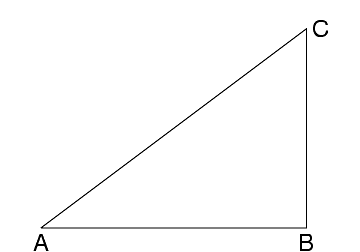
;triangle (0,0)(4,0)(4,3) ;label (0,0)"_A" ;(4,0)"_B" ;(4,3)">C"
into the picture:

More examples can be found on the gpdiagram examples page.
gpdiagram triangle. (You should see a screen
image of the triangle above.) infile and write an
image into outfile, run gpdiagram infile
outfile. The image type will depend on outfile's
extension (postscript for .ps, png for
.png). Leaving off outfile entirely will
result in a screen image. To read from standard input, use
- for infile. To write to standard output,
use -.ps or -.png for
outfile.
#Line (0,1) (2,3) #Label (4,5)"A" #(6,7)"B"
has an object of type "line" with parameters (0,1) (2,3), and two objects of type "label": the first with parameters (4,5) "A", and the second with parameters (6,7) "B".
Gpdiagram takes only numbers and quoted strings as parameters. In
particular, it will ignore any punctuation (including newlines) except
for the parsing character and (non-parsing-character) punctuation
inside a quoted string. For example, the string #Line (0,1)
(2,3) is equivalent to the string #Line 0 1 2 3.
This means that you are free to punctuate as you wish.
| Arrow (1,2) (3,4) | Draws an arrow from (1,2) to (3,4) |
| Bezier (1,2) (4,3) (5,6) | Plots a bezier curve with these points as "control points" |
| Circle (0,1) 2 | Draws a circle with center (0,1) and radius 2 |
| Circle (0,1) 2 {0,90} | Draws the part of the circle with center (0,1) and radius 2 that has (polar) angle between 0 and 90 degrees |
| Color "red" | Sets the color (options are black, red, green, blue and varies) |
| Comment "Hello world" | This is ignored |
| Dimensions 10 8 | Indicates that the diagram will be about 8 units wide by 10 units high (used only to calculate label offsets) |
| Ellipse (0,1) [2,3] | Draws an ellipse with center (0,1), x-radius 2 and y-radius 3 |
| Ellipse (0,1) [2,3] {0,90} | Draws the part of the ellipse with center (0,1), x-radius 2 and y-radius 3 that has (polar) angle between 0 and 90 degrees |
| Font "Courier" 24 | Sets the font to 24-point Courier (used only for postscript output) |
| Graph 1:2 "ln(x)" | Plots the graph of ln(x) from x=1 to x=2??? |
| Label(1,2)"A" | Centers the label A at the point (1,2) |
| Line (1,2) (4,3) (5,6) | Plots a polygonal line through the three points |
| Point (1,2) | Plots a point at (1,2) |
| Rectangle (0,1) (2,3) | Draws the rectangle with diagonally opposite corners (0,1) and (2,3) |
| Set "bmargin 1" | Runs the gnuplot command "set bmargin 1" (this sets the bottom margin to be 1 character wide) |
| Spline (1,2) (4,3) (5,6) | Plots a cubic spline through the three points |
| Title "Hello World" | Writes a diagram title |
| Triangle (1,2) (3,4) (5,6) | Draws a triangle with the given vertices |
This program is free software; you can redistribute it and/or modify it under the terms of the GNU General Public License as published by the Free Software Foundation; either version 2 of the License, or (at your option) any later version.
This program is distributed in the hope that it will be useful, but WITHOUT ANY WARRANTY; without even the implied warranty of MERCHANTABILITY or FITNESS FOR A PARTICULAR PURPOSE. See the GNU General Public License for more details.
I'd very much appreciate bug reports (and suggested solutions if you have them), requests for features, and notes of appreciation. While the script suits my needs, I am sure that there are many ways it can be improved, and your feedback will help that process greatly. I can be reached at millermj.mail.lemoyne.edu (replace the first dot with an @).